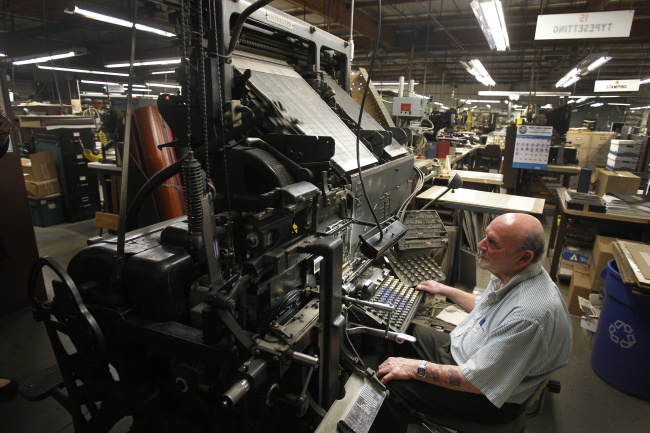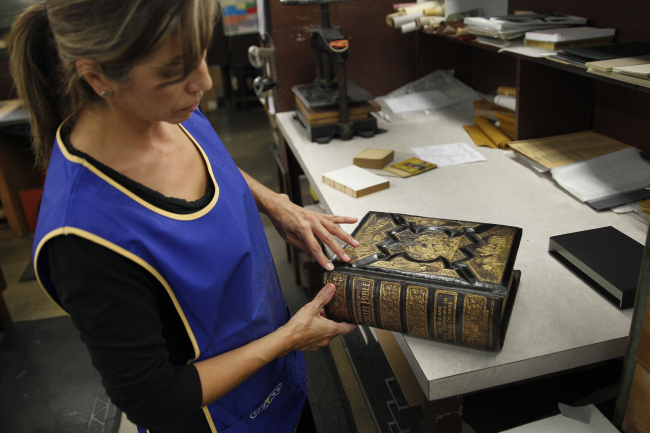Bookbinding businesses keep the pages turning, for now
By Korea HeraldPublished : Jan. 8, 2015 - 21:06

The symptoms were grim: advanced age, crumbling physical condition, broken spine. The operation would last several hours and require meticulous care. But recovery was likely, and the procedure would cost only $100.
The patient was a 90-year-old family Bible in need of major restoration.
“I always tell people that I compare book restoration with face-lifts,” said Bruce Kavin, one of three siblings who run Kater-Crafts Bookbinders. “Generally speaking, the less you do, the better.”
The Pico Rivera company has survived for 66 years while many other bookbinding companies have failed. But it hasn’t been painless. Where 100 people once worked, now only a dozen ply the trade.
That sort of contraction is common given the share of readers opting for e-books rather than the paper variety. The e-book crowd has risen to 28 percent of Americans, age 16 or older, from 17 percent in 2011, according to the Pew Research Center.
From a pre-recession high of 72,000 print and bindery employees nationwide in 2006, the profession suffered one of the sharpest declines of any occupation, according to the Bureau of Labor Statistics. By 2012, the number of jobs had plunged nearly 24 percent to 55,000, with the slide expected to continue.
The bookbinding industry has had to become nimble. It endured the loss of considerable library and academic work, for example, as more publications became available online. The disappearance of many bookstores was another blow.
“It will ... never be as much as it used to be,” said Mariana Blau, who runs A-1 Bookbinding, which has been operating in downtown Los Angeles for 55 years. She employs two full-time workers, down from a peak of nine.
Blau’s company has kept going partly through high-end projects for Hollywood actors and directors who want to commemorate films they have been part of, as well as jobs for other specialty clients.
Even with a smaller business, finding new workers is difficult.
“Nobody wants to work with their hands. Nobody wants glue on them,” Blau said. “There are very few young people who would be interested in this.”
In 2013, the 108-year-old Guild of Book Workers surveyed its members ― professionals and amateur enthusiasts ― and found that nearly 59 percent were 55 or older.
Guild President Mark Andersson, 56, has run Panther Peak Bindery, near Tucson, Ariz., since 1998. He is optimistic that there will always be a need for his kind of work.
The patient was a 90-year-old family Bible in need of major restoration.
“I always tell people that I compare book restoration with face-lifts,” said Bruce Kavin, one of three siblings who run Kater-Crafts Bookbinders. “Generally speaking, the less you do, the better.”
The Pico Rivera company has survived for 66 years while many other bookbinding companies have failed. But it hasn’t been painless. Where 100 people once worked, now only a dozen ply the trade.
That sort of contraction is common given the share of readers opting for e-books rather than the paper variety. The e-book crowd has risen to 28 percent of Americans, age 16 or older, from 17 percent in 2011, according to the Pew Research Center.
From a pre-recession high of 72,000 print and bindery employees nationwide in 2006, the profession suffered one of the sharpest declines of any occupation, according to the Bureau of Labor Statistics. By 2012, the number of jobs had plunged nearly 24 percent to 55,000, with the slide expected to continue.
The bookbinding industry has had to become nimble. It endured the loss of considerable library and academic work, for example, as more publications became available online. The disappearance of many bookstores was another blow.
“It will ... never be as much as it used to be,” said Mariana Blau, who runs A-1 Bookbinding, which has been operating in downtown Los Angeles for 55 years. She employs two full-time workers, down from a peak of nine.
Blau’s company has kept going partly through high-end projects for Hollywood actors and directors who want to commemorate films they have been part of, as well as jobs for other specialty clients.
Even with a smaller business, finding new workers is difficult.
“Nobody wants to work with their hands. Nobody wants glue on them,” Blau said. “There are very few young people who would be interested in this.”
In 2013, the 108-year-old Guild of Book Workers surveyed its members ― professionals and amateur enthusiasts ― and found that nearly 59 percent were 55 or older.
Guild President Mark Andersson, 56, has run Panther Peak Bindery, near Tucson, Ariz., since 1998. He is optimistic that there will always be a need for his kind of work.

“I like to think that everyone has one book that is very important to them that they want to preserve,” Andersson said, noting that he endures frequent kidding for his hopeful “one-book theory.”
Still, he has concerns.
“In 50 years, when people no longer have the cultural connection to what a book means, are they really going to want to fix up Grandma’s cookbook?”
At Kater-Crafts Bookbinders, the owners are getting up in years but have found the resourcefulness needed to seek out new customers.
“Our customers are the people who still love books,” said Bruce Kavin, who, at 67, is the youngest of the three siblings who run the business co-founded by their father, Mel. Kavin works with his sister, Judy Howard, 71, and brother Richard Kavin, 73.
But “part of the story is what we used to do and what we do now,” he said.
“We started out, in 1948, as a library bindery, maybe working on 300 books at a time that needed a new cover,” Kavin said about the early days when his father ran the company out of the family home.
About a year ago, Kater-Crafts was at a crossroads. Down to 25 employees from 100, it was still doing library work, and ending up in the red.
“The library work was dragging us down,” Kavin said. “It was risky, but we decided to concentrate on specialty work. We cut the payroll in half and actually started making some money.”
The zeal the three still bring to their work came from Mel Kavin. Their father was a true lover of books, collecting some no larger than a quarter coin and working on others so large that they had to be moved by forklift.
“Our father enjoyed producing odd things,” Kavin said, pointing out an unusual collection that would rival anything in the Smithsonian Institution’s back rooms.
“The first one he did was using monkey fur for the cover of a copy of Charles Darwin’s ‘Origin of Species,’” Kavin said. Another from the 1970s was a whale skin cover for a copy of “Moby Dick.”
That the company would turn to specialty work was not surprising; it had already been doing small projects for actors, writers and sports figures for years.
Tom Cruise was a customer for a while, often presenting cast and crew with specialized “behind the scenes” photo books for his movies, including “War of the Worlds” and “The Last Samurai.”
Athletes often want a book that documents their careers. These have included baseball Hall of Famer Cal Ripken Jr. and former LA Laker Shaquille O’Neal.
A look through Kater-Crafts’ workshop turns up projects for an LA restaurant and a golf course. Another was a picture book for an exclusive pre-school.
Restorations involve some of the most intricate craftsmanship. Crumbling pages are encapsulated between thin sheets of clear nylon.
“We take the covers off and clean off the old glue. Put on a new coat of adhesive and then start to put the book back together,” Kavin said.
Mel Kavin, who died in 2006 at 89, was actively running the business into his last decade. His children wonder about what comes next, given that none of their children are interested in the business.
“We’d love to see it continue on after us,” Kavin said. “By whom or in what form, we don’t know.”
By Ronald D. White
(Los Angeles Times)
(Tribune Content Agency)
-
Articles by Korea Herald






![[From the Scene] Monks, Buddhists hail return of remains of Buddhas](http://res.heraldm.com/phpwas/restmb_idxmake.php?idx=644&simg=/content/image/2024/04/19/20240419050617_0.jpg&u=20240419175937)








![[From the Scene] Monks, Buddhists hail return of remains of Buddhas](http://res.heraldm.com/phpwas/restmb_idxmake.php?idx=652&simg=/content/image/2024/04/19/20240419050617_0.jpg&u=20240419175937)

![[KH Explains] Hyundai's full hybrid edge to pay off amid slow transition to pure EVs](http://res.heraldm.com/phpwas/restmb_idxmake.php?idx=652&simg=/content/image/2024/04/18/20240418050645_0.jpg&u=20240419100350)

![[Today’s K-pop] Illit drops debut single remix](http://res.heraldm.com/phpwas/restmb_idxmake.php?idx=642&simg=/content/image/2024/04/19/20240419050612_0.jpg&u=)